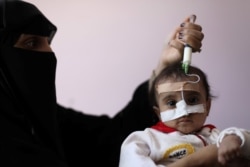The lives of thousands of children under the age of five in war-torn Yemen are at risk because of acute malnutrition, according to the U.N. Children’s Fund.
A UNICEF press release said Tuesday that is particularly true in southern parts of the country, where more than half-a-million cases have been reported, and about one in five children are suffering from acute malnutrition. The analysis shows a 10 percent increase in cases of malnutrition and a 15.5 percent rise in acute cases in 2020. The report said that leaves at least 98,000 children at risk of dying if they don’t receive urgent intervention.
Apart from children, at least a quarter-million pregnant or breastfeeding women also are in need of treatment for malnutrition, according to the statement.
“The lives of thousands of children and women are at stake. Acute malnutrition can be treated and prevented with a package of key services, but for that, we need urgent action and support. A great sense of urgency should prevail in making the necessary financial resources available and ensuring access to children and women in dire need of assistance,” said Philippe Duamelle, UNICEF Yemen Representative.
Yemen has long been regarded as unsafe for children and women because of insufficient and poor-quality diet, a high prevalence of communicable diseases, and elevated levels of food insecurity. Yemeni children also have limited access to nutrition and health services, poor sanitation and hygiene, and little or no access to vaccines such as measles and polio.
In the worst-hit areas, such as the Hodeidah lowlands, at least one in four children is severely malnourished. Other deeply affected areas include Abyan, and the Lahj and Taiz lowlands. Data for northern Yemen is still being analyzed, although the situation is expected to be same.
Pushed to the brink
U.N. experts cautioned that the actual number could be higher because the causes of malnutrition in Yemen have worsened in 2020. This year, the improvements in the lives of Yemeni women and children have been reversed because of a combination of factors. Escalating conflict and economic decline, coupled with the devastating impact of the COVID-19 pandemic, have pushed an already exhausted population to the brink.
“The vicious cycle of conflict and hunger in Yemen is exacting a terrible toll on those who are already the most vulnerable. Rising rates of acute malnutrition put too many women and children at risk while the consequences will be felt by Yemen for generations to come,” said Laurent Bukera, World Food Program Country Director in Yemen.
The experts also say this is the highest number of malnutrition cases since Yemen’s civil war began in 2015.
Lack of funding
Funding shortfalls have disrupted the implementation of many aid projects, including emergency food assistance. Malnutrition treatment programs also could be curtailed if funds are not received soon. As of mid-October, only $1.43 billion of the $3.2 billion needed in 2020 had been received, the UNICEF press release said.
U.N. Humanitarian Coordinator for Yemen Lisa Grande said the inability to increase humanitarian efforts in Yemen because of insufficient funding is “heartbreaking.”
More than 24 million Yemenis require some form of humanitarian assistance and protection.
“This means building, restoring and sustaining food systems in Yemen by immediately expanding efforts to protect people’s livelihoods and enabling them to produce, sell and consume diverse and nutritious foods even during times of extreme crisis,” said Dr. Hussein Gadain, a U.N. Food and Agriculture representative in Yemen.









